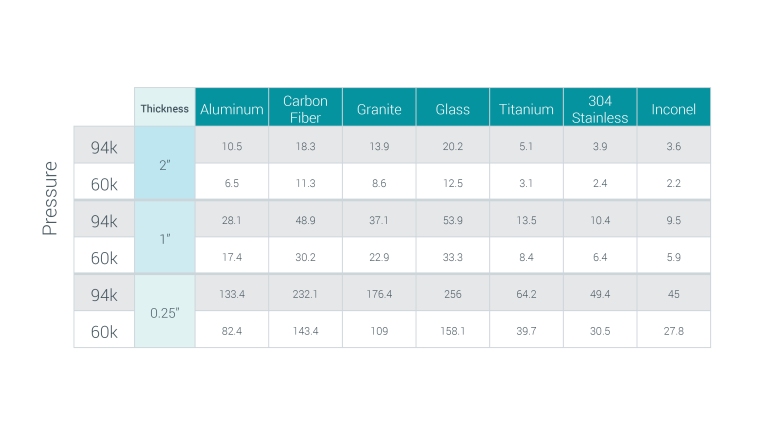In 1984 the abrasive waterjet was released as a commercially available product. It was powerful, it was incredibly versatile; but it took a special operator to run it. Someone who was into it – who had caught the waterjet bug. Why? Because at the time, waterjet wasn’t all that easy to run.
I had the unique opportunity to be such a waterjet operator by getting into abrasive waterjet just one year after it was released. While in undergrad and grad school running the waterjet laboratory and demo center I could reference basic cut speed tables for what was believed (at that time) to be the best operating parameters. The table included water pressure, orifice size, mixing tube size, abrasive size, abrasive flow rate and the maximum cut speed for a dozen common materials at one or two thickness levels.

Current data for separation cut speeds in inches per minute. When abrasive waterjet was released the operating pressure was 36,000 psi, so speeds were much slower.
With this data as a guide a waterjet operator still had to cut a part, flip it over to look at the geometry, and see where cut speed needed to be slowed to improve the result. Cutting a decent part required lots of short test cuts, lots of modifying programs and parameters after inspecting parts, and lots of patience.
It was clear that the waterjet process was not scalable at this time, meaning it would not be widely used. To go beyond being a specialty tool for solving difficult cutting problems, the process needed to be simplified for the operator – made far easier to run, easier to get to peak performance, and quicker to get to a good part. Here’s where it gets interesting.
It was found that the abrasive waterjet had some very unique characteristics. Once we found the most powerful and effective parameter sets we usually didn’t have to change those parameters at all going from one material to another, from one thickness to another – except of course cut speed. I like to compare the abrasive waterjet to a chain saw – you run the same chain saw on all types of wood, and all thickness of wood, and you typically run that chainsaw flat out with the trigger pinned at maximum. So, going from a piece of 3 inch (76mm) titanium to 0.25 inch (6mm) aluminum, to 1 inch (25mm) stone the only parameter changed on the abrasive waterjet is cut speed – still amazes me to this day.
The next thing that was discovered was that mathematical models could be created to predict the cutting result based upon the operating parameters. Glenn Erichsen conducted the experiments in the very early 1990’s and created the mathematical models that are still used today. Sure, they are constantly refined, but the jump that occurred in abrasive waterjet cutting when these first models were created was significant.
How were they used? The models allowed us to provide extremely accurate cutting data for any material, any thickness, and any set of jet parameters. The operator just had to enter the material type, thickness, jet parameters (which usually didn’t change) and the quality level of edge finish that he/she wanted and the machine knew how fast to go. If we came across a material that had never before been cut, a new model could be created by the operator simply making a few test cuts and entering the results into the intelligent control.
The intelligence of the models was so great that more than just cut speed could be predicted. It was found we could also accurately predict the stream deflection and changes within the material. This led to two sequential advances. Even smarter programs and machine controls were developed that slowed down appropriately at corners and sped up on straights to provide the fastest finished part to the geometry that was desired. Those of you very familiar with abrasive waterjet are already thinking of the next thing these models produced – Dynamic waterjet® cutting. Dynamic waterjet is where the cutting head is angled over to one side to compensate for the V-shaped taper automatically. In addition, Dynamic waterjet tilts the head forward slightly to compensate for stream lag. The result is 2 to 4 times faster cutting with tolerances down to 0.002 inch (0.5mm).
In short, if I were to name the most significant development that opened the door for the abrasive waterjet to enter into the world of mainstream manufacturing, it was the mathematical modeling of the process. Models that accurately predict the performance of the jet in the material ushered in the ability to get an operator to be trained in a day and proficient in a week, running at peak performance, and pulling great parts of their machine on the first try.
As usual, please respond below with comments on this post of ideas for future posts.
chip

Great post. The first waterjet part I ever cut was in the 1990’s, right about the time the market was transitioning to the Erichsen models you mention above. Without these models, I remember cutting a part within .010″ and feeling like I had just accomplished something really special. It was only a year or two later that I cut a part within .005″ and hardly had to try. Virtually overnight, operators with zero experience were on a level playing field with even the most seasoned waterjet applications people.
LikeLike
Indeed. With great parameters comes great power too…But based on my experience, it is quite difficult to find the best for parameters for my regular use. It is a bit trial and error.
LikeLike
Indeed. The future is bright with waterjet because they are quick and flexible. The advancement and long years of development now resulted in better quality and controllability.
LikeLike
Nice post.Waterjet process can be controlled by the program.
Water jet Cutting Services
LikeLike